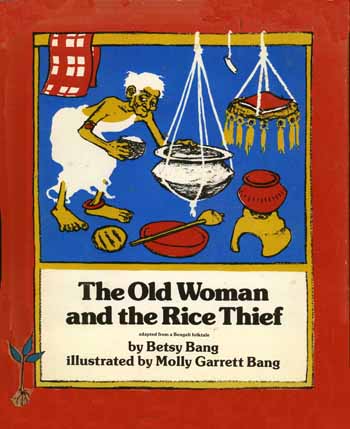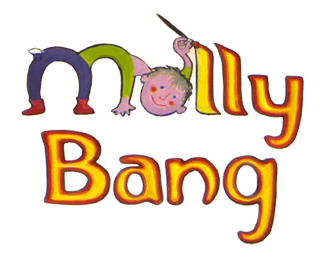
The Old Woman and the Rice Thief
Adapted from a Bengali folktale by Betsy Bang
Illustrated by Molly Bang
First published in 1978
About the Story
When this book was published in 1978, it was costly for a company to print a book in full color, because of the following:
In order for a full color picture to be reprinted, the different colors have to first be separated out and made into separate films of a single color—usually the four colors blue(cyan), red (magenta), yellow, and black. This will enable all the colors in the rainbow to be printed, since orange is made of yellow and red, purple from red and blue, green from blue and yellow, and so forth. Then each film has to be etched onto a metal plate, and each plate has to be wrapped around a printing roller.
The four rollers are placed in a row, each with a different color of ink dribbling onto them from a sort of trough above it. Then a big stack of white paper is fed in from the beginning of the row, and passes through each roller immediately one after the other, getting printed with each color in turn. At the end of the row, the whole picture appears, with all the colors in the rainbow.
But back in 1978, if you were not a very well-known and very popular author-illustrator—in other words, if the company couldn’t be sure your book was going to sell a LOT of copies—you had to separate the different colors yourself. This means that for every page of The Old Woman and the Rice Thief, I had to make the basic picture in black ink, and then I placed a piece of clear plastic acetate on top, perfectly aligned so everything I painted in would exactly match up with the black outlines, and then I painted in black and grey all the places I wanted to be, for example, red or pink (or purple or orange). Then I put another piece of acetate on top of that for everything that was going to be yellow (or green or orange), and the same for blue (green or purple or light blue).
So it took a long, long time. It was especially difficult because I decided to make the endpapers be quite complicated: a reproduction of the beautiful cross-stitch quilts that Bengali women make from the threads from old clothes—and from embroidery thread imported from China.
Nobody much cares about the endpapers or even notices them, but it made me happy just to be showing this beauty that the poorest women can make from leftover bits.
And in the original story, the thief is a person. I changed it into a rat, because in India, even with modern storage facilities, about 15-20% of the rice crop is lost to rats and mice and birds and other critters that want the harvest as much as humans do.
copyright 2018 by Molly Bang


